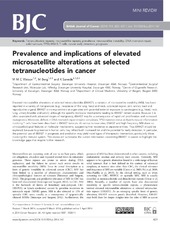| dc.description.abstract | Elevated microsatellite alterations at selected tetranucleotides (EMAST), a variation of microsatellite instability (MSI), has been reported in a variety of malignancies (e.g., neoplasias of the lung, head and neck, colorectal region, skin, urinary tract and reproductive organs). EMAST is more prominent at organ sites with potential external exposure to carcinogens (e.g., head, neck, lung, urinary bladder and colon), although the specific molecular mechanisms leading to EMAST remain elusive. Because it is often associated with advanced stages of malignancy, EMAST may be a consequence of rapid cell proliferation and increased mutagenesis. Moreover, defects in DNA mismatch repair enzyme complexes, TP53 mutation status and peritumoural inflammation involving T cells have been described in EMAST tumours. At various tumour sites, EMAST and high-frequency MSI share no clinicopathological features or molecular mechanisms, suggesting their existence as separate entities. Thus EMAST should be explored, because its presence in human cells may reflect both increased risk and the potential for early detection. In particular, the potential use of EMAST in prognosis and prediction may yield novel types of therapeutic intervention, particularly those involving the immune system. This review will summarise the current information concerning EMAST in cancer to highlight the knowledge gaps that require further research. | en_US |

